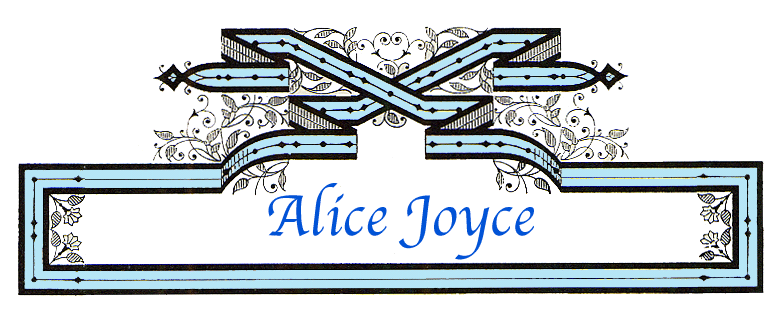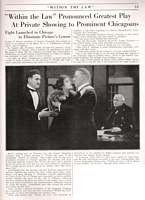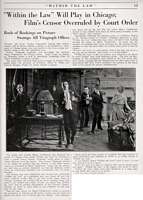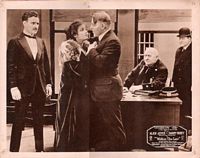

Within the Law (1917) Vitagraph Co. of America. A Special Blue Ribbon Feature. Distributor: Greater Vitagraph (V.L.S.E., Inc). Supervisor: J. Stuart Blackton. Director: William P.S. Earle. Scenario: Eugene Mullin. Camera: Clark R. Nickerson. Editor: Viola Mallort. Artistic effects, Ferdinand Early. Musical accompaniment arranged by S.M. Berg. Cast: Alice Joyce, Harry T. Morey, Adele de Garde, Anders Randolf, Walter McGrail, Eugene O'Rourke, Billie Billings, Miss Bunce, Joe Donohue, Bernard Randall, Bernard Siegel, Robert Gaillard, Victor A. Stewart. 9 reels. This film appears to be LOST
This story had been a hit play with Jane Cowl, has been novelized, and has been remade at least three times, by Norma Talmadge in 1923, Joan Crawford as Paid in 1930, and Ruth Hussey in 1939. It had been previously made into a film in Australia in 1916, of which about 30 seconds survive. Adele de Garde, who plays Aggie Lynch in this 1917 version, was a child actress in the Griffith Biograph company and is a recognizable face in many of his early films. She moved to Vitagraph afterward and was with them for many years. She seems to have dropped out of films in 1918.
| A herald for this film--outside |  |
| The inside of the herald |  |
 |
A photo of Joyce advertising the film. |
 |
Two articles about a Chicago censorship dispute involving the film from Vitagraph's Exhibitors Plan Books from 1917 courtesy of Derek Boothroyd |  |
 |
A lobby card courtesy of Derek Boothroyd, with a similar image of Joyce and Morey to the article on the left |
See also a Lantern Slide advertising this film from the collection at the Cleveland Public Library
| Mary Turner | Alice Joyce |
| Joe Garson | Harry T. Morey |
| Aggie Lynch | Adele DeGarde |
| Mr. Gilder | Anders Randolf |
| Inspector Burke | Eugene O'Rourke |
| District Attorney Demarest | Robert Gaillard |
| Helen Morris | Billie Billings |
| Sarah | Miss Bunce |
| Detective Cassidy | Joe Donohue |
| English Eddie | Bernard Randall |
This feature should get the money on the strength of its title alone. It is a Greater Vitagraph in nine reels. This is just about three reels too many. As a six-reeler it would be the goods. The early portion of the picture, which, incidentally, is shown in two sections, is extremely slow and draggy, and there are times when one simply wants to get up and howl at the titles. In its original form "Within the Law" carries so much comedy relief to its forceful drama, but this has all been lost in the picture. In casting the piece, too, there has been a woeful lack of understanding of the needs of the principal woman's role. Alice Joyce, who plays Mary Turner, is so far overshadowed by Harry Morey as Joe Garson that it is a pitiful, especially when one recalls that it is Mary Turner that was "the" role in the spoken production of the piece. Adele DeGarde as Aggie Lynch, which in reality is nothing more than a comedy foil for the lead, had something on the star, judging from the impression she left on the minds of the audience. The production was made under the direction of William P.S. Earle, of course under the personal supervision of J. Stuart Blackton. The balance of string of credits for work on the feature includes Clark R. Nickerson, photographer, who caught some clever shots; Violet Mallory, who edited the feature; Ferdinand Earle; who furnished the artistic effects and S.M Berg, who arranged the musical accompaniment. There are two points about the picture that will have to be cleared up. The first is up to the director, who for some reason or other, but mostly because he wanted a shot of the skyline of New York, sent Mary Turner from her little furnished room somewhere in the New York slums all the way to the Jersey side of South Brooklyn to jump off the dock. The other is the quick turn that Mary has with the real estate grafter. Where does the shop girl get her bright idea from all of the sudden? The speed of this transaction is a little too fast for even the most gullible of the film fans to believe. What "Within the Law" needs most to make it a good picture is judicious cutting in spots and building in others. The latter can be easily accomplished by retitling here and there.
Five-Part Drama Adapted from the Play by Bayard Veiller. Featuring Alice Joyce and Harry T. Morey. Produced by Vitagraph under the Direction of William P.S. Earle.
| Mary Turner | Alice Joyce |
| Joe Garson | Harry T. Morey |
| Aggie Lynch | Adele DeGarde |
| Mr. Gilder | Anders Randolf |
| Dick Gilder | Walter McGrail |
| Inspector Burke | Eugene O'Rourke |
| District Attorney Demarest | Robert Gaillard |
| Helen Morris | Billie Billings |
| Sarah | Miss Bunce |
| Detective Cassidy | Joe Donohue |
| English Eddie | Bernard Randall |
| Tom Dacey | Bernard Seigel |
The original plot of "Within The Law" is particularly adaptable to scenario form and promises to give the film much of the popularity that greeted this Broadway success on the stage. While the screen version must necessarily be approached from a different angle and is handicapped by the absence of the play's clever dialogue, the skilful direction and adroit handling of leaders has given the full significance of this drama of love and law. Above all, the film owes its merit to the fortunate combination of Alice Joyce and Harry Morey in the principal roles. There is something in the frail helplessness of Alice Joyce, balanced by the indomitable soul looking out of her great eyes that fits the character of Mary Turner to the life and makes her a very real and appealing person even under the screen limitations, which denied her the voice for her lines. This last deficiency is overcome as far as possible by the sub-titles which give a terse presentation of the girl's warped philosophy and her outbursts against an unjust social system.
The story has been familiar to theater goers ever since the play made its first success. The misfortune of Mary Turner who serves a term in prison for a theft she never committed and who resolves to wreak her vengeance on her persecutors by a system which keeps within the law, have been wept over in every small town that a road company could ever reach. The development of this system which breaks down under a very genuine love affair, makes up a human melodrama which, in spite of its sensational developments keeps within the limits of plausibility and common sense.
Exhibitors will find excellent advertising value in the title of a play which has been universally popular on the road as well as on Broadway.
"Within the Law"
Vitagraph Releases Eight-Reel Screen Version of Bayard Veiller's Celebrated Melodrama--Alice Joyce and Harry Morey Head the Cast.
Reviewed by Edward Weitzel.
ALL things considered, the screen version of Bayard Veiller's melodrama, "Within the Law," produced by the Vitagraph, is a creditable piece of work. Some portions lose considerable of the force of the original from not having the same amount of speed. This is most apparent in the murder scene of the third act, the flashing from one character to the other affecting the intensity of the situation. The general impression made by the photoplay is excellent, but it also shows that there is room for improvement in moving picture technic when transforming a stage melodrama into a screen play. The spoken drama is able to dismiss many necessary minor points with a word of explanation and hurry on to the big moments; while the screen pauses to visualize incidents that help to clarify the story, at the expense of the dramatic action. Of all forms of fiction, pure melodrama is the most difficult of assimilation by the screen, as the art is practiced at the present time.
The merits of the version of "Within the Law," "edited" by Violet Mallory and directed by William P.S. Earle are sufficient to afford most persons a liberal amount of enjoyment. The story in itself is full of appeal, and has been put together by its author with unusual skill. It will be followed with interest throughout the entire eight reels. There is shown in the production a desire to keep it at a high standard. The mountings are correct, and the cast has been carefully selected. Alice Joyce is the Mary Turner. Failure to always get under the skin of the character deprives her impersonation of the warmth and the human touch it requires. Mary Turner is a woman who feels deeply and suffers accordingly. Great strength of will was require to change her from the simple young girl of the earlier scenes to the woman who left the prison, armed and ready to fight falsehood and trickery with its own weapons. There qualities are not indicated by the actress.
Harry Morey as Joe Garson is such a likable chap that it is hard to reconcile him with his police record. He carries out his conception consistently, however, and is effective at all times. Adele DeGarde as Aggie Lynch must be credited with one of the best performances in the picture. In a character easy to overplay she strikes just the right note, and her amusing unmorality is always without offense. Eugene O'Rourke's Inspector Burke is another faultless character study. Anders Randolf, Walter McGrail, Billie Billings, Joe Donohue, Bernard Randall, Bernard Siegel, Robert Gaillard and Miss Bunce are correctly cast.
Another review from Moving Picture World, June 9, 1917
WITHIN THE LAW (May)--The cast: Mary Turner (Alice Joyce); Joe Garson (Harry Morey); Aggie Lynch (Adele De Garde); Mr. Gilder (Anders Randolf); Dick Gilder (Walter McGrail); Inspector Burke (Eugene O'Rourke); Dist. Atty. Demerest (Robert Gaillard); Helen Morris (Billie Billings); Sarah (Grace Bunce); Detective Cassidy (Joe Donohue); English Eddie (Bernard Randall); Tom Decey (Bernard Siegel). Directed by William P.E. Earle.
Mary Turner is accused of the theft of another department store employe. Notwithstanding her protestations she is convicted and sent to prison for three years. But before starting her trip to Sing Sing she is granted an interview with Gilder, the proprietor of the department store, her accuser. She first begs for mercy which is refused, and then she gives him the solution of stopping the store thefts.
"Pay your girls more than six dollars a week" she tells her former employer. "That will stop the thefts, and save the girls," He sneers at her advice.
While studying law in prison Mary realizes that there are many ways of breaking the law and yet remaining "Within the Law." This discovery is made use of by Mary upon her release from prison. Without funds, she is thrown on the bounty of member of the underworld, forgers, burglars and a woman parasite. She is their adviser. They break the law continually but still remain "Within the Law."
Aggie Lynch, the parasite, enslaves a man of wealth. She suggests blackmail by selling back to him the love notes he has written to her. Mary shows that the legal blackmail is a breach of promise. The result is the same but the consequences differ. Aggie gets her $10,000 by settlement of the breach of promise case. She remains out of prison to where she would have gone had she attempted to sell her letters directly to her admirer.
Mary, herself, obtains $30,000 from two real estate swindlers who first attempted to swindle her. She keeps the $30,000, laughs at the swindlers and remains "Within the Law."
Joe Garson, noted as a forger and the lover of Aggie, falls in love with Mary. He watches over her, protects her in every way.
As a direct contradiction of this is "English Eddie," another underworld character who becomes a spy for the police, leads his companions into a burglary prearranged for the benefit of the police, which causes his murder by Joe Garson but ends in the arrest of the entire outfit.
Mary later captivates Dick Gilder, the son of the department store proprietor who caused her arrest. She ensnares him and marries him. Then she informs her antagonistic father-in-law. "You gave me a prison number and I have changed it for your name."
Eventually the Gilder shop girl who stole from her employer and secreted the stolen merchandise in Mary's locker, confessees and the play is brought to a conclusion with the most dramatic scene of the entire play, when Joe confesses to the murder of English Eddie and in the presence of her husband takes leave of Mary preparatory to his trip to the electric chair.
A MOVIE "WITHIN THE LAW."
None of the Thrills Lost from the Stage Version.
Bayard Veiller's famous melodrama, "Within the Law," which has the enviable record of thing the most popular and financially successful melodrama produced within the last decade, reached the moving picture screen yesterday when it was shown at the Broadway Theatre. The melodrama has been converted by the Vitagraph into a photoplay that consumes a whole evening in the unreeling, and upon the making of which more than the usual care has been bestowed.
It seemed altogether probable that "Within the Law" would make an interesting photoplay, just as it was an unusually thrilling drama, and this probability the picture at the Broadway confirms. The story of Mary Turner, the shop girl wrongfully convicted of a crime, who dedicates her life on her release from prison to questionable practices that are just within the law with the end in view of avenging her great wrong by making the man responsible suffer, contained the dramatic action that proves most potent for screen uses.
The play as it was acted for more than a year at the Eltinge has been followed closely by the picture makers. There are many interpolated scenes, of course, because the movies are not restricted by time or place, but they are well within the confines suggested by Mr. Veiller's play, in the development of the original plot and in its staging a higher degree of intelligence than is sometimes evident in movies is manifest.
Alice Joyce acted the role of Mary Turner, Harry Morey was the screen Joe Garson, and Adele de Garde (at least, so the program said) acted the flashy role of Aggie Lynch. It will be recalled that Jane Cowl, William B. Mack, and Florence Nash, respectively, played these roles at the Eltinge. The mediums of screen and stage are so vastly different that it is impossible to compare the acting of one with the other, so it can only be said that Miss Joyce, Mr. Morley [sic], and Miss de Garde acted their parts well.
The picture emphasized the greater effectiveness of spoken humor over printed. Full use of the slangily pungent speeches of Aggie Lynch has been made, and while they never failed to create a ripple of merriment, there was never a spontaneous laugh, such as always punctuated the performanaces of the play when Miss Nash read them in her inimitable manner. A novel device in quoting dialogue is used to such good effect that it might be adopted universally for indicating direct discourse in the movies.
Instead of flashing a complete speech on the screen and holding it there long enough for the slowest reader to digest it, the words appear successively until the speech is complete. This at least suggests the illusion of speech, and also makes it easier to read. Also it substitutes motion for the inanimate stretches of the old-fashioned sub-titles.
Within the Law, with Alice Joyce in the part Jane Cowl created on the stage, lacks the great stream of human humor which swept the spoken play like a torrent--which made it great. Within the Law is simply a melodrama, one of many.
Last revised July 15, 2013